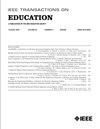Exploring the Role of Interfaces in Microcontroller Circuits: An Analysis of Students’ Performance and Usability
IF 2
2区 工程技术
Q2 EDUCATION, SCIENTIFIC DISCIPLINES
引用次数: 0
Abstract
Contribution: This study focuses on microcontroller circuits and aims to: 1) investigate the impact of formal reasoning on students’ post-knowledge using catastrophe theory; 2) compare the different combination sequences of tangible user interface (TUI) and graphical user interface (GUI); and 3) assess the usability of both interfaces and explore potential correlations between perceived usability and students’ post-knowledge. Background: Although in the existing literature, there are a few studies investigating the role of the sequence of TUI and GUI in students’ post-knowledge, particularly in the microcontroller circuits there is a notable lack of related studies. Also, in this field, the effect of formal reasoning on students’ post-knowledge has not been investigated. Research Questions: Does formal reasoning affect students’ post-knowledge in microcontroller electronic circuits? Does interface sequence have any impact on students’ post-knowledge? Does interface sequence impact students’ usability perception of the TUI and GUI? Does student perceived usability correlate with their post-knowledge? Methodology: The intervention had a sample size of 134 university students who conducted four microcontroller exercises. In addition, statistical analysis employed the nonlinear Cusp catastrophe model, t-tests, and ANCOVA along with bootstrapping. Findings: Interface sequence has no impact on students’ post-knowledge, while students’ answers showed a significant difference in the evaluation of usability in favor of the real circuit. Cusp model showed that formal reasoning influences achievement and can act as bifurcation factor denoting that beyond a threshold value nonlinear changes in performance can occur.探索接口在微控制器电路中的作用:学生的表现和可用性分析
贡献:本研究以微控制器电路为研究对象,旨在:1)运用突变理论探讨形式推理对学生后知识的影响;2)比较有形用户界面(TUI)与图形用户界面(GUI)的不同组合顺序;3)评估两种界面的可用性,并探讨感知可用性与学生后知识之间的潜在相关性。背景:虽然在现有文献中,有一些研究调查了TUI和GUI的顺序在学生后知识中的作用,特别是在微控制器电路中,相关研究明显缺乏。此外,在这一领域中,形式推理对学生后知识的影响尚未得到研究。研究问题:形式推理是否影响学生对微控制器电子电路的后知识?界面顺序对学生的后知识有影响吗?界面顺序是否影响学生对TUI和GUI的可用性感知?学生感知的可用性与他们的后知识相关吗?方法:干预的样本量为134名大学生,他们进行了四次微控制器练习。统计分析采用非线性Cusp突变模型、t检验、ANCOVA和bootstrapping。研究发现:界面顺序对学生的后知识认知没有影响,但学生对实际电路可用性的评价存在显著差异。Cusp模型表明,形式推理影响成绩,并可以作为分岔因素,表明超过阈值后,成绩可能发生非线性变化。
本文章由计算机程序翻译,如有差异,请以英文原文为准。
求助全文
约1分钟内获得全文
求助全文
来源期刊

IEEE Transactions on Education
工程技术-工程:电子与电气
CiteScore
5.80
自引率
7.70%
发文量
90
审稿时长
1 months
期刊介绍:
The IEEE Transactions on Education (ToE) publishes significant and original scholarly contributions to education in electrical and electronics engineering, computer engineering, computer science, and other fields within the scope of interest of IEEE. Contributions must address discovery, integration, and/or application of knowledge in education in these fields. Articles must support contributions and assertions with compelling evidence and provide explicit, transparent descriptions of the processes through which the evidence is collected, analyzed, and interpreted. While characteristics of compelling evidence cannot be described to address every conceivable situation, generally assessment of the work being reported must go beyond student self-report and attitudinal data.
 求助内容:
求助内容: 应助结果提醒方式:
应助结果提醒方式:


